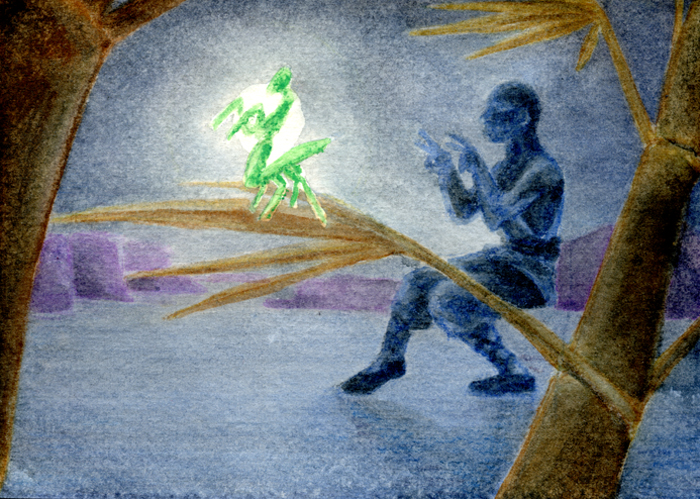“With illustrator Patrick Lugo’s colorful, energetic paintings, author John Fusco has brought to life an inspiring tale of the development of one of the many styles of Shaolin Kung Fu — a style derived from one young monk’s observation of a praying mantis. To paraphrase the teachings of one of the monks in the book, Fusco’s story has good Kung Fu.”
~~ Peter Laird, “Teenage Mutant Ninja Turtles”
 In the opinion of the illustrator, who’s publishing experience includes comics and magazines, praise from such a transformative figure in modern comics’ history remains a high water mark for this premiere children’s book. This is also the author’s first children’s book, though not the first story John Fusco has written for children. In his own words, the origin of LITTLE MONK AND THE MANTIS is as follows.
In the opinion of the illustrator, who’s publishing experience includes comics and magazines, praise from such a transformative figure in modern comics’ history remains a high water mark for this premiere children’s book. This is also the author’s first children’s book, though not the first story John Fusco has written for children. In his own words, the origin of LITTLE MONK AND THE MANTIS is as follows.
“My last children’s story was the Dreamworks animated film SPIRIT: STALLION OF THE CIMARRON), but this book is special to me for another reason: I believe that martial arts education at a young age has helped me in all facets of my life and work, and it’s something that I want to share with young readers whether or not they choose to practice the art itself. Ultimately, martial art is an art of peace; the art of avoiding conflict through self-discipline and being one with nature. It is, as the sages of old have described it, a treasure. LITTLE MONK AND THE MANTIS is an origin story set in the world of ancient Chinese Gong-fu, the “Grandfather” of all martial arts styles.
The book came into being during the development phase of the movie THE FORBIDDEN KINGDOM. Between 2005-2008 I was flying to China and back quite frequently. On one of those early trips, I spent some quality time with Jet Li, immersed in Kung Fu history, philosophy, and lore. Jet had found it intriguing that I, an American, practiced what he called “old school” Praying Mantis Kung Fu (thanks to my Sifu Arthur Makaris).
Jet and I had a lot of discussion about the history/legend behind Mantis origins, and I guess it had taken deep root in my mind; on the notoriously long flight back to the US, I kept waking from dreams about the young Wong Long and his relationship with “the Shaolin monk of the insect world”, the praying mantis. The origin story was so thematically rich and colorful that it seemed a shame that it was unknown outside of China. At the same time, my work on FORBIDDEN KINGDOM was all about introducing my young son to basic Kung Fu lore (and cool Shaw Bros. movies), so I ordered a pot of green tea, took out a legal pad and a pen, and began writing a kid-friendly version of the Wong Long story. As I wrote, I imagined the kind of book it could be with a unique illustrator who understood Kung Fu. By the time we landed in Vancouver, my first children’s book was done.
On a whim, the name Tuttle Publishing came to me because I have a martial arts eastern history and philosophy library by my bed. It’s the stuff I love to read at night before I fall off to sleep. And I always got a kick of the fact that every third title I would pick up, it would seem, was Tuttle. And I loved their slogan: Tokyo, Singapore, Rutland Vermont. That just fascinated me because I live in Vermont. I thought, “Who are these people?” I did a little bit of research and read Mr. Tuttle’s story—thought it was fascinating. So I packed up the manuscript, typed a cover letter and sent it to Tuttle. And then I never heard anything and completely forgot about it. It was months later when I got an email from their acquisitions editor. And he said, “We love this book. It’s not what we do, but it’s taken a while because we’ve just kept passing it to the next group, and everyone’s come back, and we feel strongly enough about it to take a gamble on something we don’t normally do. Where can I send a contract?” It was great.
The next big question was, “Do you have any illustrators in mind?” I reached out to my friend Gene Ching. When he mentioned Patrick’s name, I knew of him. I had read Tiger’s Tale and was aware of his work. I looked into his portfolio and felt, “Wow. This guy’s got it.” He understands what it’s about and he’s got something fresh. He can capture—and again I’ll use the zen—simple zen images. And yet there’s also something irreverent about his style that’s youthful and accessible. We had our initial conversations and I felt he’s got it. He did some mock ups, a few rough sketches that we got to Tuttle. They came back quickly and said, “We agree with you. This is the guy.” So that’s how it all came together and took off running.”
While some conceptual artwork had been developed during the very early stages of this project, it seems the book’s spirit resides somewhere between continents. Having just received it, I brought my copy of the manuscript on an eight city tour of Europe. The following thumbnail sketches were doodled into the manuscripts margin during the dark hours flying over the Atlantic.








